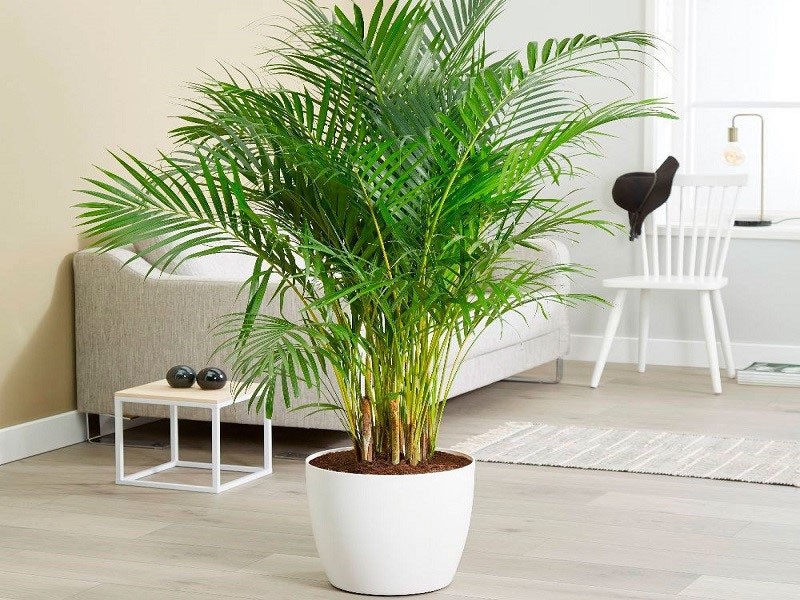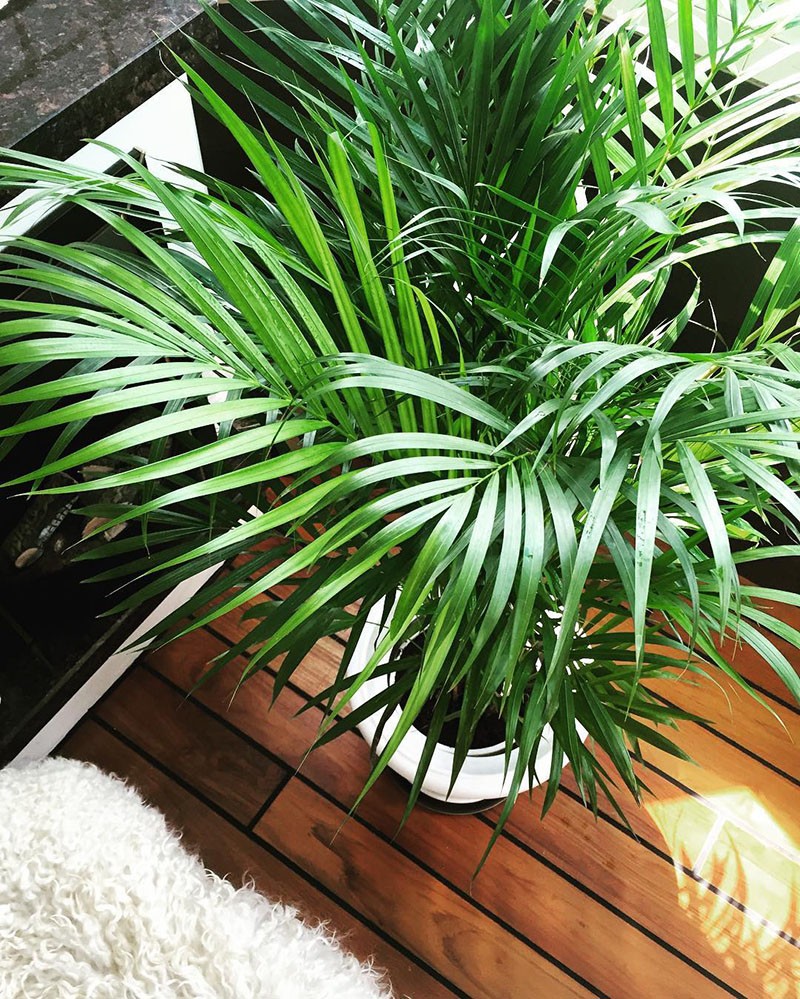Decorative palm tree for home and office - indoor flower chrysalidocarpus
 The indoor flower chrysalidocarpus is a real palm tree, native to the tropics of Madagascar and the Comoros. If in nature the genus Chrysalidocarpus has up to 20 species, then only one of them is used for the house - Chrysalidocarpus yellowish. It is suitable for growing in pots and is appreciated by experienced growers for its ease of maintenance, quick care and a spectacular appearance.
The indoor flower chrysalidocarpus is a real palm tree, native to the tropics of Madagascar and the Comoros. If in nature the genus Chrysalidocarpus has up to 20 species, then only one of them is used for the house - Chrysalidocarpus yellowish. It is suitable for growing in pots and is appreciated by experienced growers for its ease of maintenance, quick care and a spectacular appearance.
Home care

To keep your indoor chrysalidocarpus flower growing large and healthy, follow a few tips for caring for it.
Temperature regime
 Plant conditions should be close to natural. In summer, place the pot in a room where the temperature is kept within 22-25 degrees. In winter, it may be slightly less, but not lower than 16 degrees.
Plant conditions should be close to natural. In summer, place the pot in a room where the temperature is kept within 22-25 degrees. In winter, it may be slightly less, but not lower than 16 degrees.
High humidity and watering
 Humid air is another component of the tropical climate. If the indoor air is dry, regularly spray the green part of the plant with a spray bottle. In winter, the procedure can be skipped.
Humid air is another component of the tropical climate. If the indoor air is dry, regularly spray the green part of the plant with a spray bottle. In winter, the procedure can be skipped.
Frequent watering is an important condition for the growth of chrysalidocarpus. Palm is sensitive to the composition of water, its leaves lose quality from too hard liquid or excess of impurities. Use soft bottled water for watering or let sit for several days. In autumn and winter, you can water the plant less often, but prevent the soil from completely drying out.
Soil for growing palm trees
 The substrate should be light but nutritious, well-draining, neutral or acidic. There are ready-made substrates for indoor palms on sale - beginners should choose this option. At home, you can prepare a mixture using one part of peat, earth with the addition of sand and charcoal, as well as 2 parts of a clay-grain additive and humus.
The substrate should be light but nutritious, well-draining, neutral or acidic. There are ready-made substrates for indoor palms on sale - beginners should choose this option. At home, you can prepare a mixture using one part of peat, earth with the addition of sand and charcoal, as well as 2 parts of a clay-grain additive and humus.
Top dressing of indoor palm and transplant
 Fertilizers - recommended for chrysalidocarpus throughout the year. Choose special mixtures for palm trees or complex dressings for indoor flowers - they contain all the necessary trace elements. In the summer, add them every 2-3 weeks, in the fall and winter, you can reduce the amount to 1 time per month.
Fertilizers - recommended for chrysalidocarpus throughout the year. Choose special mixtures for palm trees or complex dressings for indoor flowers - they contain all the necessary trace elements. In the summer, add them every 2-3 weeks, in the fall and winter, you can reduce the amount to 1 time per month.
 Transplant - is necessary as the palm grows. For young plants, the procedure is carried out once a year, for specimens over 6 years old - once every 2-3 years. In mid-spring, take out the chrysalidocarpus along with the rhizome and earthy clod, move it to a larger pot. Do not be afraid to damage the small side roots - this will not affect the condition of the palm tree.
Transplant - is necessary as the palm grows. For young plants, the procedure is carried out once a year, for specimens over 6 years old - once every 2-3 years. In mid-spring, take out the chrysalidocarpus along with the rhizome and earthy clod, move it to a larger pot. Do not be afraid to damage the small side roots - this will not affect the condition of the palm tree.
The plant's name comes from the Greek word for "golden fruit". In nature, the fruits really have a yellow tint, but in domestic plants the chrysalidocarpus palm does not bloom and does not bear fruit.
Reproduction of chrysalidocarpus
 At home, chrysalidocarpus can be propagated in two ways: seeds and rhizome. Both of these methods are simple, but it will take time to grow a new specimen.
At home, chrysalidocarpus can be propagated in two ways: seeds and rhizome. Both of these methods are simple, but it will take time to grow a new specimen.
Check out the main features and choose which method is more suitable:
- Soak the seeds in warm water for several days before planting. An important condition is that the water must maintain a temperature of 25-30 degrees so that the seeds germinate faster. Then transplant them into soil and place them in a warm, well-lit area. It can take from 3 to 4 months from the moment of planting to the appearance of several true leaves.
- Chrysalidocarpus can also propagate by root shoots (vegetatively). To do this, use a sharp knife to separate the process near the base of the palm tree, which already has its own rhizome. It can be immediately planted in the soil and looked after like an adult palm tree.

The easiest way to propagate chrysalidocarpus at home is to cut off a small root shoot during plant transplant.
The seeds can be purchased from the store by selecting a variety. At home, they are not formed, since the palm tree blooms only in natural conditions.
Diseases and pests
 Even well-kept potted plants at home can suffer from diseases and pests. Pay attention to the first symptoms in order to start treating the palm tree in time.
Even well-kept potted plants at home can suffer from diseases and pests. Pay attention to the first symptoms in order to start treating the palm tree in time.
Chrysalidocarpus may have the following diseases:
- fungal infection - oval or round spots appear on the leaves, brown with a light edging;
- worms - pests that are on the lower surface of the leaves and cause them to dry out;
- mites - the leaves also dry out when they appear, but before that they are covered with small spots with a yellow tint.
In case of fungal infections, remove all damaged areas and treat the plant with fungicides. Insecticides work well against pests.
Plus, regular treatments will help keep your indoor palm healthy and protect it from various diseases.
Possible growing problems
 Chrysalidocarpus is an easy plant to care for, but beginners can face difficulties. A change in the appearance and condition of a palm tree is a sign that some factors in its content need to be changed.
Chrysalidocarpus is an easy plant to care for, but beginners can face difficulties. A change in the appearance and condition of a palm tree is a sign that some factors in its content need to be changed.
It is important to understand what different problems are talking about.:
- yellowish chrysalidocarpus leaves dry - insufficient watering or low air humidity, the appearance of pests;
- brown spots on the surface of the leaves - a fungal infection, too hard water for irrigation, or sudden changes in temperature;
- coloring the tips of the leaves in a brown shade - low temperature and humidity, rare watering;
- yellowing of leaves - being under the open sun in summer heat, insufficient watering;
- darkening and dropping of the lower layer of leaves is a normal process of palm growth, it is enough to cut them off with a sharp knife.
To keep the shape of the indoor flower of chrysalidocarpus neat and symmetrical, regularly turn the plant over with the opposite side to the sun, especially in summer.
Popular varieties of indoor flower chrysalidocarpus
In total, there are up to 20 species of chrysalidocarpus, common in nature. They differ in appearance, may have one or more trunks.
Some plant species:
- Chrysalidocarpus yellowish is a popular variety that is suitable for growing at home in pots. It is well branched and forms rooting side shoots.

- Chrysalidocarpus three-stalked is an unusual plant, represented by long leaves that extend directly from the ground. The leaf plates are oblong, with a glossy sheen.

- Chrysalidocarpus Madagascar is a single-stemmed plant. The trunk is smooth, covered with pale bark, and the leaves are located at the top. In nature, it can grow up to 8 m in height.

Chrysalidocarpus is an unusual solution for home and office.Although it comes from the tropics, it has taken root well as a houseplant and gained popularity. Connoisseurs of this plant note that the palm tree looks good all year round and is combined with other indoor flowers.